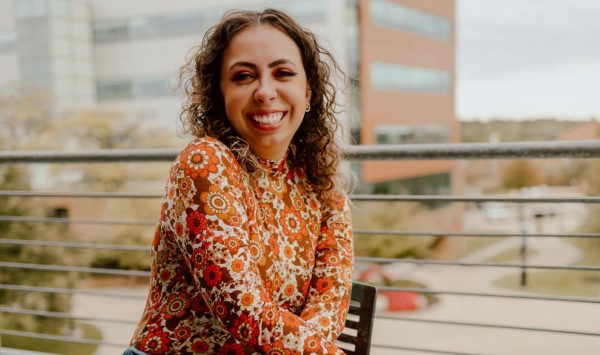Letter from the editor: Gen Z is done with just “thoughts and prayers”
Gabrielle Abdelmessih is the editor-in-chief of The Oakland Post for the 2022-2023 academic year. She is a senior majoring in biomedical sciences and minoring in journalism.
Feb. 16, 2018
I was a junior in high school, taking an AP Biology quiz. At that moment, mitosis and meiosis were the only things on my mind. Suddenly, sirens started blaring. The fire alarms were going off.
Everyone’s focus in my classroom shifted from their quizzes to the classroom door. “Oh my god,” I thought, “it might happen here.”
Just a few days ago, one might have thought this was a routine drill that got us out of class or that one of the cool chemistry teachers accidentally set off the smoke detectors again after a lab activity – but that was before a former student opened fire at Marjory Stoneman Douglas High School on Feb. 14, 2018, murdering 17 people and injuring 17 others. A fire alarm, either activated by the smoke from the gunfire or pulled by the gunman, prompted students and staff to exit the shelter of their classrooms and into the rapid gunfire.
My teacher instructed us to stay in our seats as she peered into the hallway to see what other teachers were doing. No one wanted to leave. Our principal even announced over the intercom for everyone to remain in their classrooms while they investigated why the alarms went off.
It turns out a fire alarm was accidentally pulled. Normal classes resumed, but everyone was a bit shaken up — it didn’t happen, but it very well could have.
I share this story because this is the tragic reality of a student living in the United States of America. Taking an AP Biology quiz? Laughing with your friends in the cafeteria? Walking to your locker? You could be eviscerated by an AR-15.
The possibility is always there, and most children, as well as the teachers, staff, and administrators of today, are aware of that harrowing thought. The question is, are the politicians at Capital Hill and Americans who graduated from high school before Columbine?
I grew up attending school during a time when practicing lockdown and active shooter drills were a common occurrence. School shootings were, too. Nothing has changed since I graduated from high school.
My parents didn’t grow up with those practices or the threat of a shooting. Your parents or perhaps you yourself didn’t grow up with that either. They didn’t discuss with their peers where they would hide in their school if a gunman should enter. My friends and I did. Their teachers didn’t keep bags of coins or baseball bats as classroom defense methods. Mine did. If you are a college student or younger, all of this probably sounds familiar to you, too.
The threat to American schools changed after Columbine. It is reflected in Sandy Hook, Parkland, Oxford, Uvalde and unfortunately, many more. And this isn’t the only threat of gun violence — now the leading cause of death for children in the United States — they face.
It is a public health crisis that requires comprehensive public health strategy and gun reform. If we could restrict smoking, mandate car seatbelts and establish the TSA to reduce safety risks, we can do something about this never-ending crisis.
The primarily old, white, upper-class members of Congress, who did not grow up with the threat of school shootings or in environments with stark disparities, can’t get anything done.
I don’t know about you, but I am frustrated by the lack of substantive action.
However, I do have hope. The children who have grown up in this era of violence — who will grow up, obtain positions of power and go on to have children of their own — will not tolerate this any longer.
Gen Z is done with just “thoughts and prayers.”










Gregory • Jun 17, 2022 at 10:50 AM
Gabrielle, you are mistaken. The possibility has always existed, and not just from firearms. Restricting this discussion to just firearms when other mass murders are happening using other means (you may be too young to remember the Oklahoma City bombing, for example) is not only disinenuous, but misleads people into thinking that firearms are the common factor in all of these tragic events when they are not. That in turn leads to ineffective solutions.
The truth is that mass murders began to increase in the mid 1960s. This coincides with the JFK mandate to close all the insane asylums. Unfortunately, the second phase of his plan, community mental health treatment facilities, was never implemented due to his own assasination by a mentally ill man. Since that time the dangerously mentally ill have been living freely among us, free to commit these horrible acts, which they are doing more and more frequently as the mental health crisis in this country grows. When you look at *all* the mass murders in this country, going all the way back to Lizzie Borden, you get a more accurate picture of what the commonalities really are. There is really only one, however. Mental illness.
Until we address mental illness, until we get dangerously mentally ill people off the streets and into secure and safe treatment facilities, the general public, including children in schools and daycares, will never be safe from these horrific acts. You could eliminate every gun from the planet, and they would be no safer. For the price of an AR15, and with nothing more than a state ID, a person can make a fertilizer bomb powerful enough to destroy a medium sized school or church. No background check. No waiting period. No red flag watch list. Until the dangerously mentally ill are removed from open society, nothing will change.
BTW, you should also refrain from talking about the effects of firearm use if you do not know anything about firearms. In order to be “eviscerated” by an AR15, you would have to be hit at least 20 times. They use some of the smallest bullets of any commonly used firearm.
Yousef • Jun 15, 2022 at 11:16 AM
Gen Z is one of the most anxious unhappy generations ever raised. they were raised with the live and let live mentality and were untethered from absolutes that grounded human beings for thousands of years. They are the generation screaming out in the darkness to an infinite nothing asking for meaning and answers.
It is no surprise to me to see the level of unrest, anxiety, and violence from this generation. prior to the lockdowns they were already hanging on the edge, for some school or the weekly meeting with friends were all this generation had.
for many the COVID lockdowns, i think we will find out, pushed many of this generation over the edge.
Your prescription of “doing something” i am assuming means restricting access of law abiding citizens to AR15s. This will do nothing in a country where there are more guns than people. Prior to 1986 automatic firearms were “legal” to own yet we did not have the level of school shootings present in recent times. I think this points to the problem not being in the weapon used rather the state of the population.
What needs to happen is a coming back to reality, a tethering back to the absolutes that bound us to reality and gave us a fixed point of reference for orienting ourselves in society. Young men need purpose, opportunity, and respect from society. They need to stop being told they’re toxic, evil, perpetrators of white supremacy and patriarchy and rather be built up as builders of society, as stewards of a great inheritance worth preserving for future generations.
If we were to “ban” AR15s the weapons will change to NBCs, bombs, knives. It is like changing the bandage on a gangrenous wound.
Anon • Jun 16, 2022 at 5:42 PM
So, your solution is that young people need a daily affirmation of how special they are. Got it. Very helpful.
Here is a list of school shootings prior to the year 2000, including the years prior to 1987. https://en.wikipedia.org/wiki/List_of_school_shootings_in_the_United_States_(before_2000)
Yousef • Jun 17, 2022 at 9:54 AM
I did not offer any solution, merely stated the problem is not with guns. Automatic firearms have been around for over a hundred years, before WW1. Automatic weapons, being far deadlier than an AR15 and having predated the AR15 by nearly half a century, did not lead to an uptick in school shootings despite being widely publically available. My hypothesis suggests that the underlying issue is cultural and not with guns.
The solution starts by identifying the cause first. I believe the uptick in recent years of school shootings is due to a lack of purpose and meaning in young mens lives and an erosion of moral absolutes. Men find purpose and meaning primarily by raising families, working, and building society. Men have been abdicated of this calling by our culture in recent decades. This includes constant assaults on the family structure, government subsidization of single motherhood, liberalization of divorce laws nation wide making marriage a sour deal, depiction of men in popular culture as oafs or idiots, instant access to adult content online, etc. Couple this with an erosion of moral absolutes by which we derive ideas such as the sanctity of life and we have a clearer picture of the problem.
The tools used in these massacres are irrelevant to the problem. If it wasn’t guns it would be something else such as bombs, chemical, or biological attacks.
My solution would be to reverse decades of erosion of our family values, give men a reason to live and something to lose by fortifying institutions such as marriage by reversing some of the above mentioned issues, and finally return to a reverence to moral absolutes that tethered our understanding of reality for thousands of years.